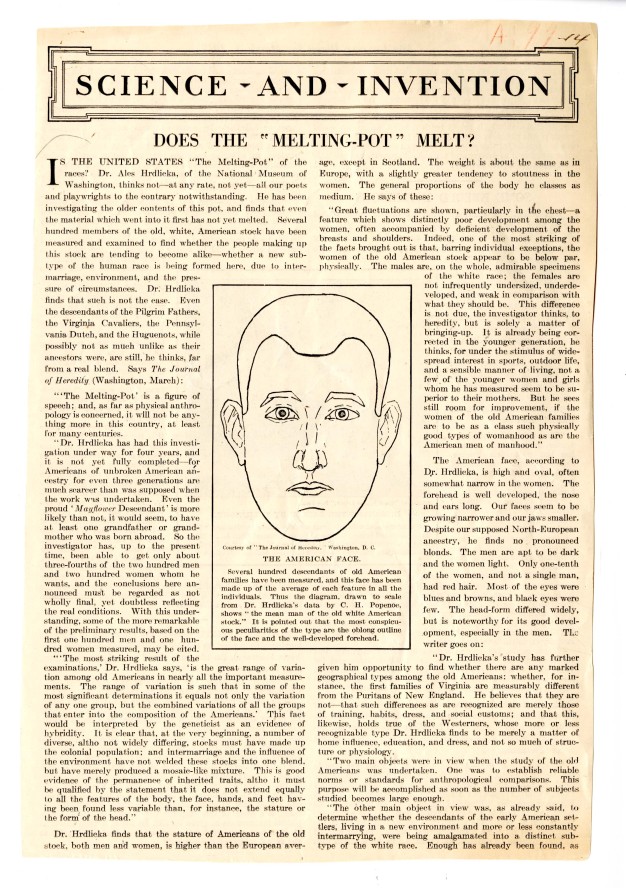Face-Off: How Race Science Factored into Regional Rivalries
Header image: “The American Face,” illustrating the Literary Digest’s article, provided courtesy of The Journal of Heredity
What does an “American” look like? In the early 20th century, scientists of anthropology, heredity, and eugenics thought it looked white and male, with a well-developed forehead. In a 1917 article titled “Does the ‘Melting Pot’ Melt?” Dr. Ales Hrdlicka, curator of physical anthropology at the National Museum of Washington, argued that America’s famous nickname was a misnomer—the melting pot, in fact, did not melt. Accompanying his article is a simple line drawing of the “mean man of the old white American stock.”
I found this article in the Eugenics Record Office’s archives at the APS while I was researching as a Mellon Foundation Short-Term Research Fellow. Archivists, or perhaps ERO staff themselves, had placed it in a folder labeled “Immigration.” This article, and the contents of this folder more broadly, reveal the ambiguous nature of race in the early 20th century. Further, the drawing included in the article reveals how scientists incorporated physicality when attempting to conceptualize “race” in relation to heredity and environment. My research has found that a reliance on visual markers of difference was not relegated to the arena of science. In California, non-scientific writers and promoters employed the language of heredity, environment, and racial science in order to argue for a Californian racial exceptionalism.

In 1916, the feminist writer Inez Hayes Irwin penned a short essay called “The Californiacs.” She writes that the California male “has eyes like mountain lakes and a smile like a break of sun.” One might think that Irwin was speaking poetically. However, she goes on to say, “California has, in its labor man, produced a new physical type. It is different from the standard American type…the ugly-beautiful face, long and lean, with its harshly contoured strength of feature…the look of labor in California is not so much of strength as of force…” Her husband, journalist Will Irwin, had argued something similar in “The City That Was” in 1906, writing that “almost has the Califorian developed a unique racial physiology.”

Accessed via Wikipedia https://en.wikipedia.org/wiki/Will_Irwin#/media/File:Nysun04211906p5.jpg
Dr. Hrdlicka appears to counter the claims of regional exceptionalism exemplified by the Irwins in “Does the ‘Melting Pot’ Melt?” by arguing that there are no distinctly-marked geographical types among the old Americans, even among the “first families of Virginia and the Puritans of New England.” Furthermore, he adds, this holds true for the Westerners, whose “more or less recognizable type” is “merely a matter of home influence, education, and dress, and not so much of structure or physiology.”
Although Dr. Hrdlicka dampens the Irwins’ claims of a physiologically-distinct Californian, plenty more Californian writers, promoters, and even scientists would continue to believe that (white) Californians did indeed have a unique racial physiology, whether resulting from environment, heredity, or a mixture of the two. The article “Does the ‘Melting Pot’ Melt,” available at the APS, reveals the larger national conversation that informed and perhaps resulted from Californians' attempts at differentiating themselves from the “average,” Eastern, American.
References:
- Ales Hrdlicka, “Does the ‘Melting Pot’ Melt?,” Literary Digest, March 3, 1917. Eugenics Record Office Papers, MS COLL No. 77, Series 1.
- Inez Hayes Irwin, “The Californiacs,” Sunset, the Pacific Monthly, February 1916. Accessed via Project Gutenberg, https://www.gutenberg.org/files/3311/3311-h/3311-h.htm.
- Will Irwin, “The City That Was: A Requiem of Old San Francisco,” The New York Sun, April 1906. Accessed via Project Gutenberg, https://www.gutenberg.org/files/3314/3314-h/3314-h.htm.


